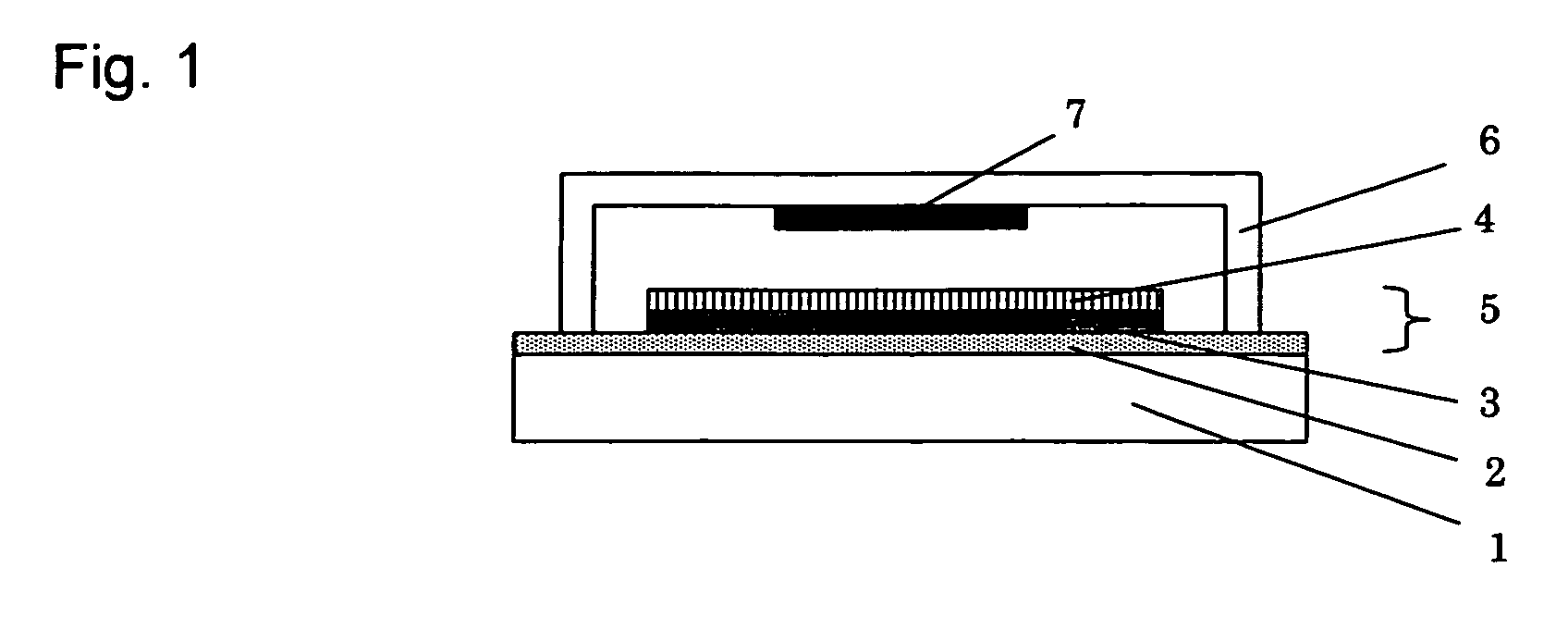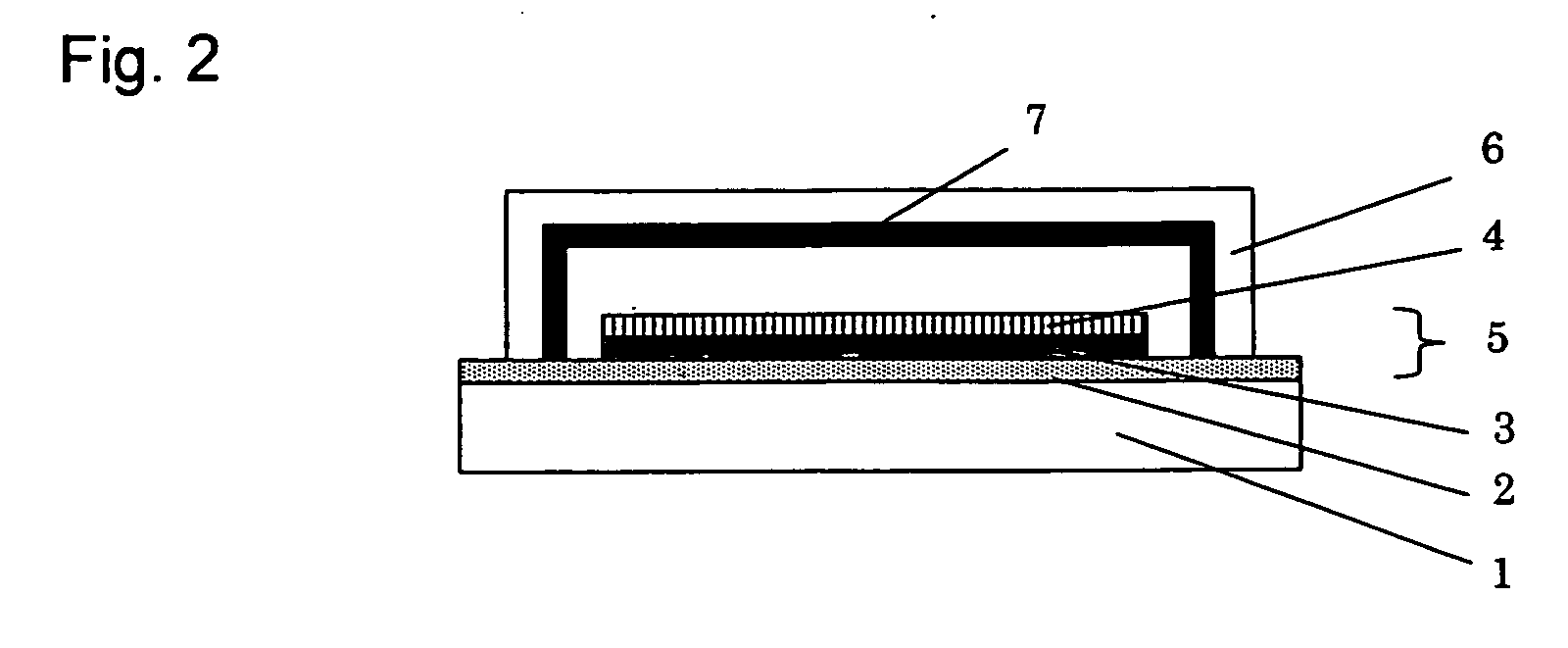Oxygen absorbent molding and organic electroluminescent element
a technology of organic electroluminescent elements and absorbents, which is applied in the field of oxygen absorbents, can solve the problems of short continuous operation life of elements, short light emitting life of elements, and degradation of luminescent properties, and achieves the effects of reducing the risk of accidental ingestion, reducing the risk of powder leakage, and superior oxygen absorption capability and mechanical strength
- Summary
- Abstract
- Description
- Claims
- Application Information
AI Technical Summary
Benefits of technology
Problems solved by technology
Method used
Image
Examples
example 1
[0105] Oxygen absorbent powder was obtained by mixing 1000 g of reduced iron powder (mean diameter: 50 μm) and 50 g of 50 wt % calcium chloride in aqueous solution, drying the obtained mixture, and then screening the dried mixture to remove coarse particles.
[0106] Subsequently, 3.0 g of this oxygen absorbent powder was mixed with 0.158 g of PTFE powder (product name “6-J”; manufactured by DU PONT-MITSUI FLUOROCHEMICALS COMPANY, LTD; melting point of 332 degrees C.) (weight ratio of the oxygen absorbent powder:PTFE=95:5), and the mixture was mixed well at room temperature (about 28 degrees C.), using a mortar. The obtained agglomerate was rolled into a sheet-form oxygen absorbent molding A (thickness: 300 μm). FIG. 4 shows a scanning electron microscope (SEM) photograph of the oxygen absorbent molding A. The oxygen absorbent molding A is a structure in which the oxygen absorbent powder containing the reduced iron powder as its principal oxidizing component is bound together and unit...
example 2
[0111] Oxygen absorbent powder was obtained by dissolving 60 g of FeSO4.7H2O and 100 g of Na2CO3.10H2O in 45 wt % sodium L-ascorbate in aqueous solution, and impregnating 600 g of activated carbon powder (mean diameter: 10 μm) with the full amount of the above-obtained solution.
[0112] Subsequently, 0.85 g of the oxygen absorbent powder obtained above was mixed with 0.15 g of PTFE powder (product name “POLYFLON F-104”; manufactured by DAIKIN INDUSTRIES, LTD.) (weight ratio of the oxygen absorbent powder:PTFE=85:15), and the mixture was mixed well at room temperature, using a mortar. The obtained agglomerate was rolled into sheet-form oxygen absorbent molding D (thickness: 300 μm). An area of size 3 cm×6 cm (0.63 g) of the oxygen absorbent molding D was cut out. The cutout piece of the oxygen absorbent molding D was put, together with 800 ml of air, in an oxygen-impermeable bag, which was then sealed. The oxygen absorbent molding D in the oxygen-impermeable bag was stored in a 60% RH...
example 3
[0113] In this example, 0.9 g of the oxygen absorbent powder prepared in the same manner as in Example 2 was mixed with 0.1 g of the same PTFE powder as used in Example 2 (weight ratio of the oxygen absorbent powder:PTFE=90:10), and the mixture was well mixed at room temperature (about 25 degrees C.), using a mortar. Then, a tablet machine (diameter: 12 mm) was filled with 0.82 g of the obtained agglomerate and compression molding was performed at a pressure of 1 t / cm2, thereby obtaining tablet-form oxygen absorbent molding E (each tablet being 12 mm in diameter and 7.2 mm high). This oxygen absorbent molding E was put, together with 800 ml of air, in an oxygen-impermeable bag, which was then sealed. The oxygen absorbent molding E in the oxygen-impermeable bag was stored in a 60% RH atmosphere at a temperature of 25 degrees C. The initial oxygen absorption speed and the maximum oxygen absorption amount on an oxygen absorbent powder weight basis were measured in the same manner as in...
PUM
| Property | Measurement | Unit |
|---|---|---|
| specific surface area | aaaaa | aaaaa |
| diameter | aaaaa | aaaaa |
| diameter | aaaaa | aaaaa |
Abstract
Description
Claims
Application Information
 Login to View More
Login to View More - R&D
- Intellectual Property
- Life Sciences
- Materials
- Tech Scout
- Unparalleled Data Quality
- Higher Quality Content
- 60% Fewer Hallucinations
Browse by: Latest US Patents, China's latest patents, Technical Efficacy Thesaurus, Application Domain, Technology Topic, Popular Technical Reports.
© 2025 PatSnap. All rights reserved.Legal|Privacy policy|Modern Slavery Act Transparency Statement|Sitemap|About US| Contact US: help@patsnap.com



